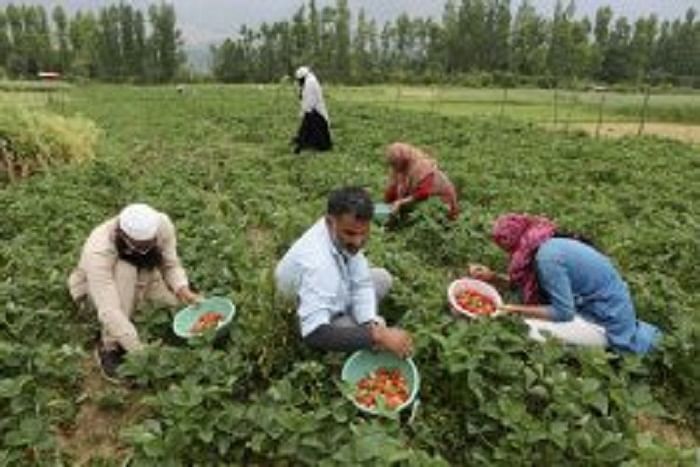
During the dream run of the economy, from 2004 to 2012, India was creating 7.5 million new non-agricultural jobs every year (a total of 52 million new jobs over seven years), while just two million people were were entering the labour force each year. The fact that India has done this before means India can do it again, provided the correct policies are followed.
The rapid growth of non-agricultural jobs enabled 5 million people to leave agriculture each year, which relieved rural distress somewhat. The share of workers in agriculture had always been falling since 1973, but the absolute numbers had always been increasing, which led to stagnant productivity. For the first time in India's history, the absolute numbers in agriculture fell after 2004, because non-agricultural jobs were being created fast during a period of unprecedented growth.
The period from 2004 to 2012 was one of labour-absorbing, inclusive growth. In real terms, this led to tightening of the rural labour market, raising open market wages; this process was further supplemented by the introduction of MGNREGA and rising MSP. As a ratchet effect, urban wages also rose in real terms (despite the rising inflation).
As a result, the elasticity of poverty-reduction to growth increased. Not only was GDP growth the fastest ever (8% per annum between 2004 and 2014), but the rate of poverty reduction improved. The responsiveness of poverty reduction to growth increased.
There was an absolute fall in the numbers of the poor by 20 million each year over 2004 to 2012 (calculated according to the Tendulkar poverty line) - an achievement of staggering proportions. While the the share of population below the poverty line had always been falling until 2004, never before had the absolute number of poor fallen since 1973 (by the Lakdwala poverty line).
The open unemployment rate of the educated was falling from 2004 to 2012.
Contrast this achievement with that of the past seven years. The number of non-agricultural jobs being created has fallen from 7.5 million each year to 2.9 million from 2012 - 2018, based on my analysis of the NSS-PLFS.
Total manufacturing jobs have fallen in absolute terms since 2012, though not in organized manufacturing sector. This is the first time in the country that manufacturing jobs have reduced, despite increasing FDI and an improving ranking of India on World Bank’s Ease of Doing Business. From 2012 to 2018, manufacturing jobs fell by 3 million; demonetisation in particular destroyed jobs in the unorganised sector.
The sectors in which manufacturing jobs fell were the most labour-intensive ones: leather, textiles, garments, wood and furniture, food processing, gems and jewelry. In these, product groups exports also suffered, so merchandise exports fell in dollar terms 2014-2018, something that had not happened since the 1990s. The ban on cow slaughter those transporting the carcass of cattle, destroying jobs related to the leather sector across the country.
Open unemployment has risen sharply from 2.2% in 2012 to 3.4% in 2015-16 to 3,7% in 2016-17 to 6.1 % in 2017-18 by the usual principal and subsidiary status of workers over the past year (all Labour Bureau or NSSO data), and 8.3% by the current weekly status. This is a 45-year high in 2018, since India started conducting labour force surveys.
Youth (15-29 year olds) unemployment had tripled from 6% in 2012 to 18% in 2018. Rural unemployment has gone to 8.5% by current weekly status (in 2018). The cow slaughter ban became an excuse for unemployed youth to extract money from meat/leather industry/transporters. The lumpenisation of newly educated but unemployed rural youth ensued.
The absolute numbers leaving agriculture, has fallen from 5 million every year (2004-11) to 1 million each year (2012-2018). This has compounded the farmer distress in agriculture. It has also stalled the structural transformation of the economy.
Post-Covid, the unemployment rate has shot up to 24% in April 2020 (from 8.3% two years earlier), and again youth are biggest sufferers. For the first time in 15 years, the numbers in agriculture rose, by 5 mn.
Real wage growth has slowed sharply post 2012; in fact it is stagnant until 2018, and will have fallen by 2020 as unemployment shot up.
The government is in denial by focusing on MUDRA and Ola-Uber jobs, when those jobs are already captured in the NSSO 2017-18 sample, which is the basis for all data on employment and unemployment above. It captures both unorganized and organized work, rural and urban, casual/regular wage work and also self-employed earnings. It leaves nothing out. The GOI was also in denial when alleging that NSS PLFS 2017-18 was not comparable to 2011-12 NSS data on jobs. No expert believes the two are not comparable.
India’s demographic dividend began in the early 1980s; it will end by 2040, when India will become an ageing society. The number of entrants into the labour force will increase at an accelerating pace from now till 2030, the labour force growth decelerating thereafter till 2040. Can India become rich before it grows old? That is the question facing policy-makers.
(Santosh Mehrotra is Professor of Economics, JNU, and has just published Reviving Jobs: An Agenda for Growth, Penguin, 2020)